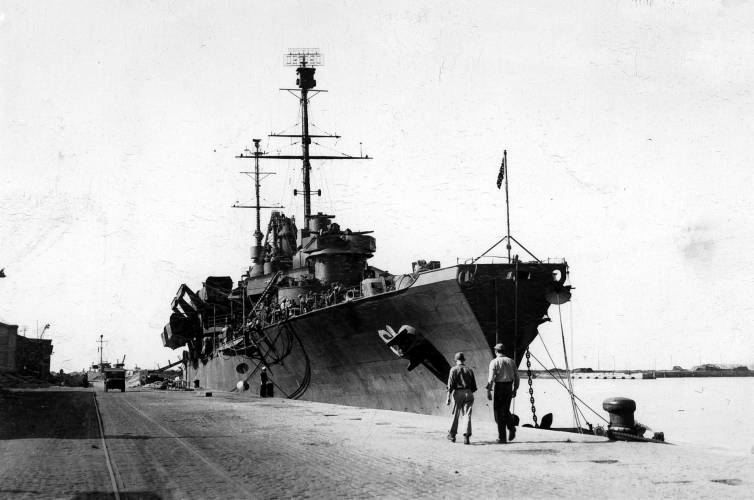
|
LSV 6 USS Montauk |
||||
| Click Here for USS Montauk Main Page | ||||
 |
Officers 114
Enlisted 450
Troop Accommodations
Officers 122
Enlisted 1236
Boats 19 LVT or 29 DUKW
Armament
two single 5"/38 cal. duel purpose gun mounts
four twin 40mm AA gun mounts
twenty single 20mm AA gun mounts
Fuel Capacities
NSFO 12,025 Bbls
Diesel 750 Bbls
Propulsion
two General Electric turbines
four Combustion Engineering 2-drum boilers, 400psi 700°
four turbo-drive Ship's Service Generators, 500Kw, 400V A.C.
two propellers, 11,000shp
A village and fishing resort on Long Island, N.Y., near Montauk Point, the eastern extremity of New York.
The fourth Montauk was laid down as AN‑2, 14 April 1942, by the Ingalls Shipbuilding Corp., Pascagoula, Miss.; launched 14 April 1943; sponsored by Mrs. G. C. Whiting; reclassified AP‑161, 2 August 1943; reclassified LSV‑6, 21 April 1944; and commissioned 6 October 1944, at Brooklyn, N.Y., Comdr. Alfred R. Boileau in command.
After shakedown in Chesapeake Bay, Montauk joined TU 29.6.11, 7 November 1944, and sailed for the west coast for assignment with Amphibious Forces, Pacific Fleet. Arriving at San Francisco on the 23d, she loaded DUKWs and LCVPs and headed for Hawaii, 25th, on her first vehicular cargo run. During the next few months, the delivery of similar cargos took her to Guadalcanal, Tulgai, Entiwetok, and Guam as well as to Hawaii.
On 2 March, she took on Army troops and equipment, sailing on the 5th for Saipan. Thence, as Allied forces in the Pacific gathered for the next campaign, she sailed west toward Okinawa. By 1 April she stood off the “Demonstration” beach on the southeast coast of that largest of the Ryukyu Islands. There she participated in the diversionary feint to draw the enemy’s attention from the Hagushi beaches, receiving within hours her first taste of Japanese kamikaze‑aerial‑resistance tactics, At 0704, she proceeded to Transport Area Easy off the west coast of Okinawa, rendezvousing with Eldorado, Vice Admiral Turner’s flagship, at 1109, and commencing the employment of her boats in the shuttling of Army staff personnel to and from Eldorado.
Her passengers and cargo, assigned to reinforcement roles, remained on board, intact, until 9 April. Emptied by the 15th, she set a course back to Saipan on the 16th. From Saipan, she made one run to the Palaus, and then headed back to San Francisco, whence she conducted amphibious supply runs to Hawaii, Eniwetok, Guam, and Ulithi through the remaining months of the war.
Following V‑J Day, Montauk transported occupation troops to Okinawa and then sailed, 30 September, for Tientsin, China, with Marine Corps personnel and equipment. Departing 10 October, she returned to the Ryukyus and then steamed on to Guam, where she embarked personnel of the 6th Marine Division for transportation to China, disembarking them at Tsingtao, 28 November. At the end of the month, she proceeded to Sasebo, Japan, and sailed from there on the 13th for Okinawa en route to San Diego.
Montauk returned to the United States 29 December and was reassigned to the Atlantic Fleet, homeported at Charleston, S.C. Renamed Galilea and redesignated AKN‑6 on 1 October 1946, she began inactivation in December 1946. Decommissioned in July 1947, she entered the Atlantic Reserve Fleet at Charleston. She remained there as a unit of the 16th Fleet until placed in the custody of the Maritime Administration in August 1960. On 1 September 1961, she was struck from the Naval Register. The following year, she was formally transferred to the Commerce Department and was laid up in the James River as a unit of the National Defense Reserve Fleet, where she remains into 1969.
Montauk received one battle star for her World War II service.